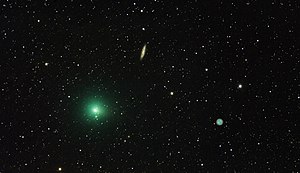41P / Tuttle-Giacobini-Kresak
| 41P / Tuttle-Giacobini-Kresak [i] | |
|---|---|

|
|
| 41P / Tuttle-Giacobini-Kresak passes Messier 108 and Messier 97 (March 22, 2017) | |
| Properties of the orbit ( animation ) | |
| Orbit type | short-term |
| Numerical eccentricity | 0.661 |
| Perihelion | 1.045 AU |
| Aphelion | 5.124 AU |
| Major semi-axis | 3.085 AU |
| Sidereal period | 5 a 153 d |
| Inclination of the orbit plane | 9.229 ° |
| Perihelion | April 13, 2017 |
| history | |
| Explorer | HP Tuttle |
| Date of discovery | May 3, 1858 |
| Older name | 1951 IV; 1951f; 1962 V; 1962b; 1973 VI; 1973b; 1978 XXV; 1978r; 1990 II; 1989b1 |
| Source: Unless otherwise stated, the data comes from JPL Small-Body Database Browser . Please also note the note on comet articles . | |
The comet 41 / P Tuttle-Giacobini-Krešák is a short-period comet with an orbital period of 5.4 years around the sun . It was discovered on May 3, 1858 by Horace Parnell Tuttle and rediscovered independently in 1907 and 1951 by Michel Giacobini and Ľubor Kresák . It belongs to the comets of the Jupiter family . The diameter of the core is estimated at 1.4 kilometers. He was last seen well in 2017:
In spring 2017 it passed through the constellations Hercules and Lyra and could be observed from midnight to dawn between 20 and 40 degrees . On May 1, 2017, it passed the spiral galaxy NGC 6585 at a distance of only 2 ' and on May 4, 2017 in the evening at 3 to 4' the star of 4th magnitude Kappa Lyrae .
See also
literature
- Stars and Space , May 2017
Web links
- 41P / Tuttle-Giacobini-Kresak in the Minor Planet Center database
- Bayerischer Rundfunk from April 12, 2017, accessed on May 2, 2020
- Gary W. Kronk's Cometography - 41P / Tuttle-Giacobini-Kresak (en.)
Individual evidence
- ↑ List of Jupiter-Family and Halley-Family Comets: List of Jupiter-Family and Halley-Family Comets , accessed May 2, 2020